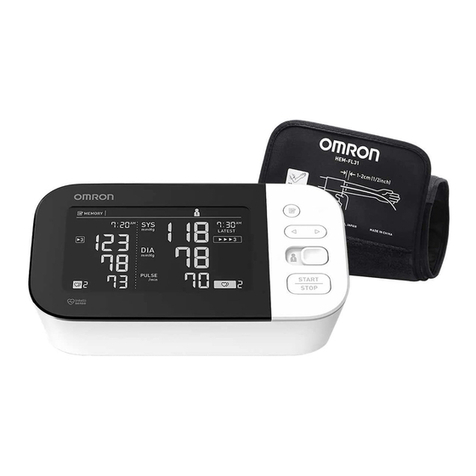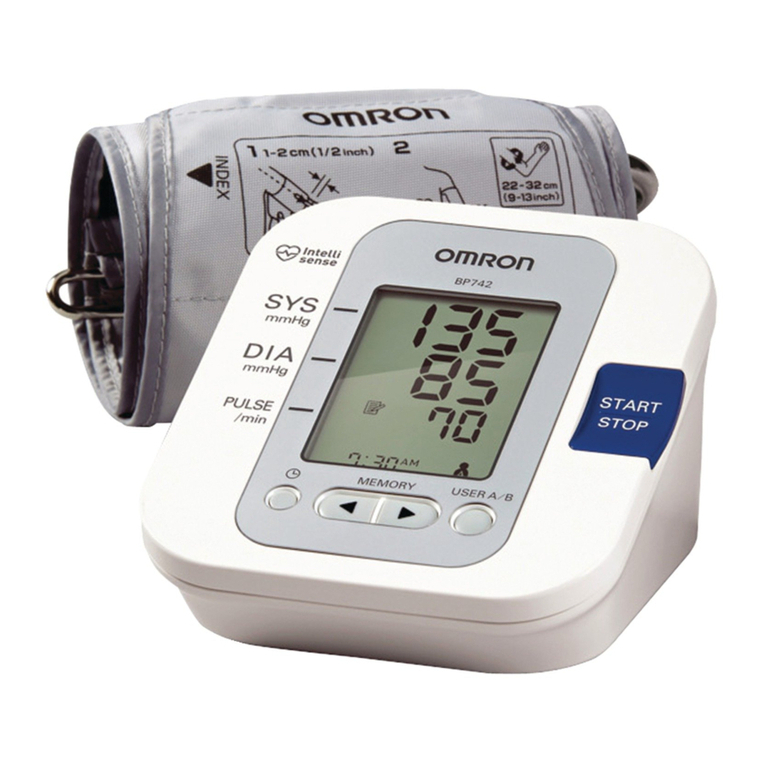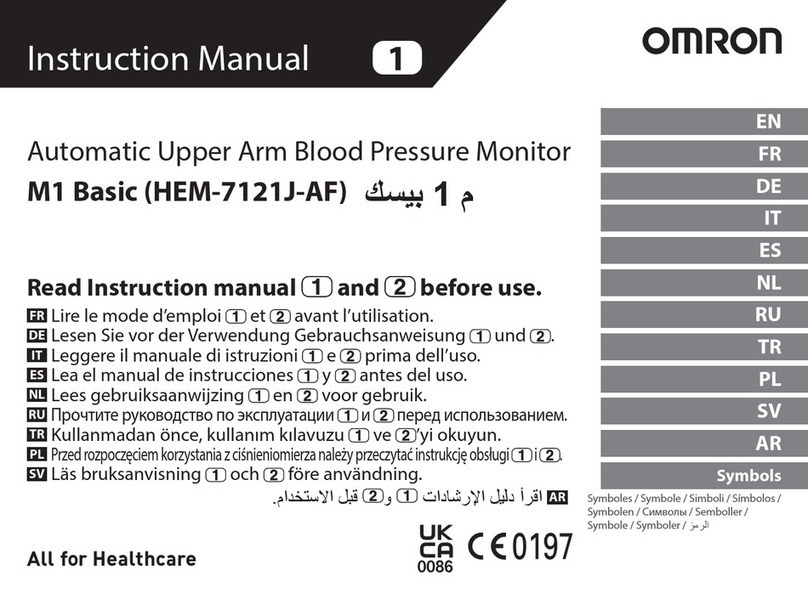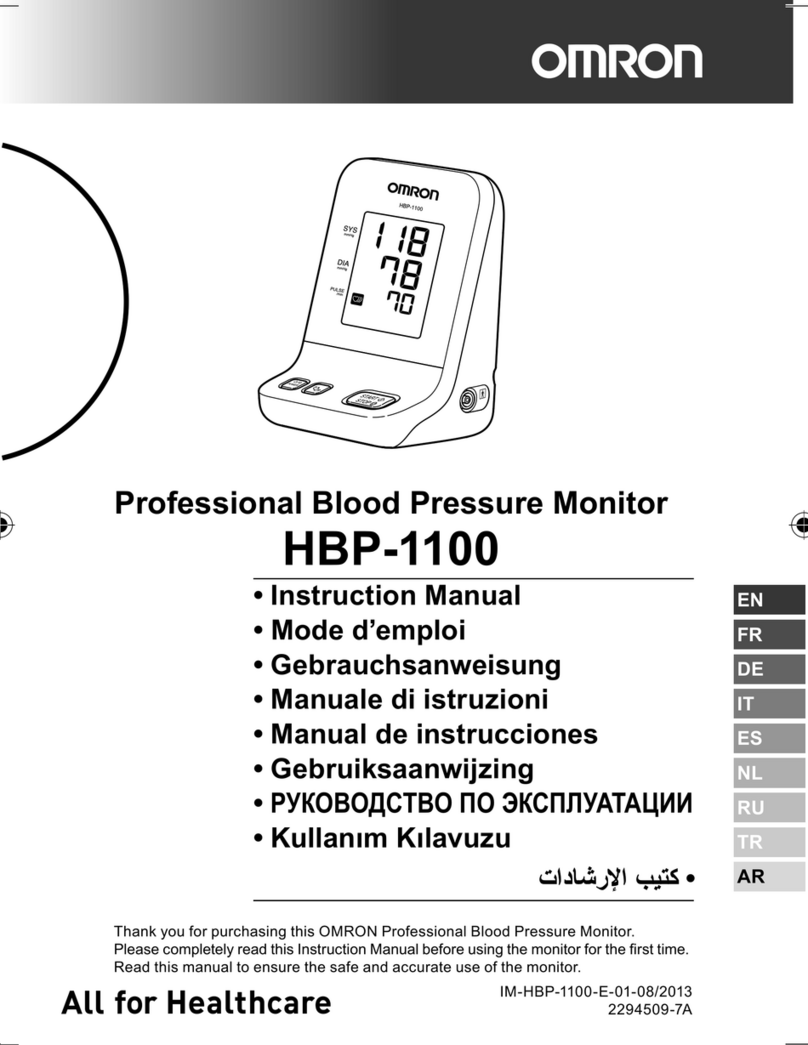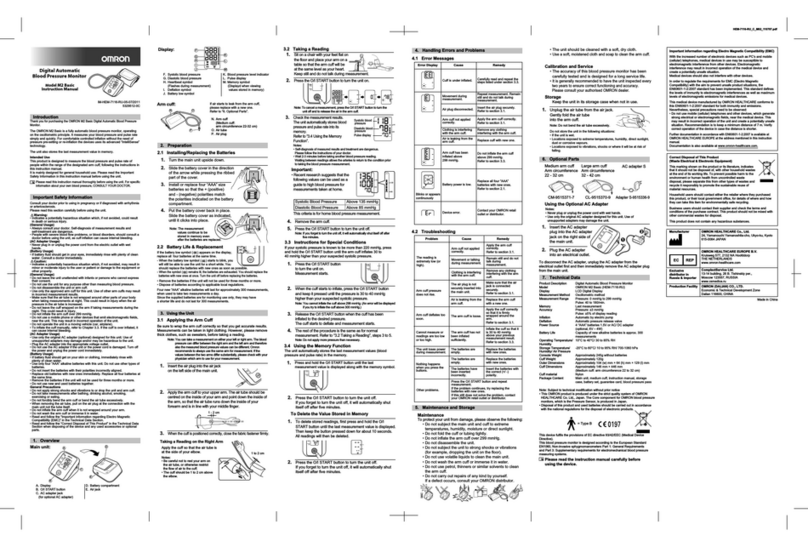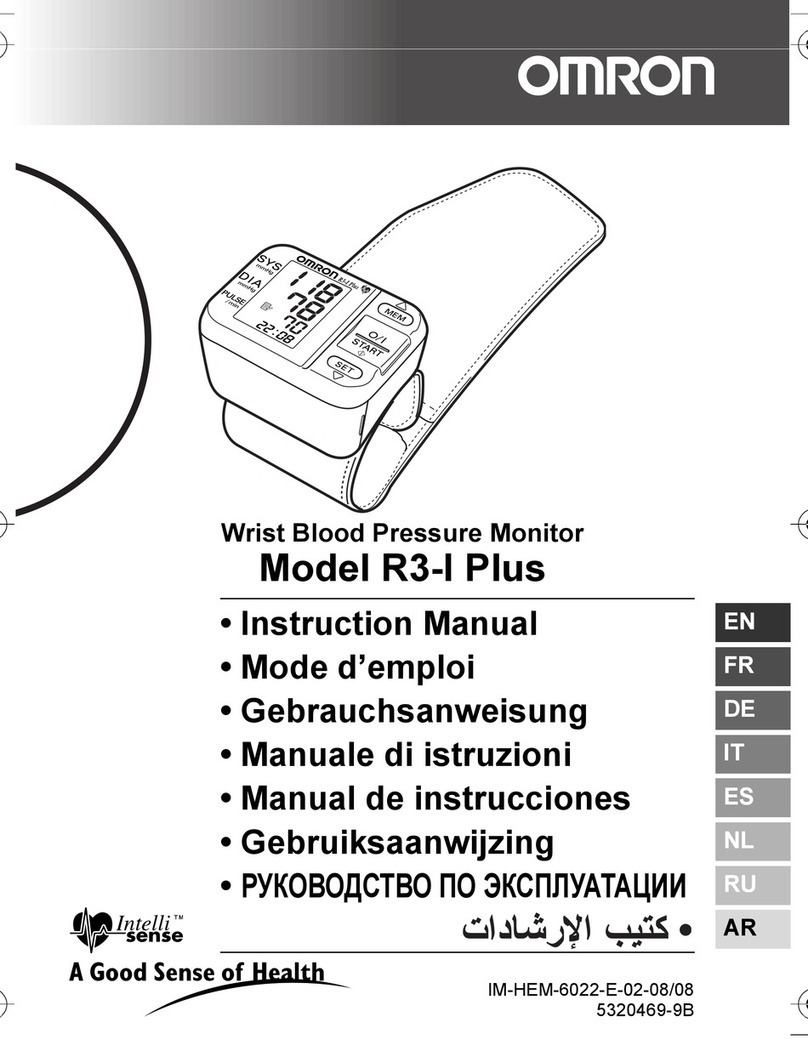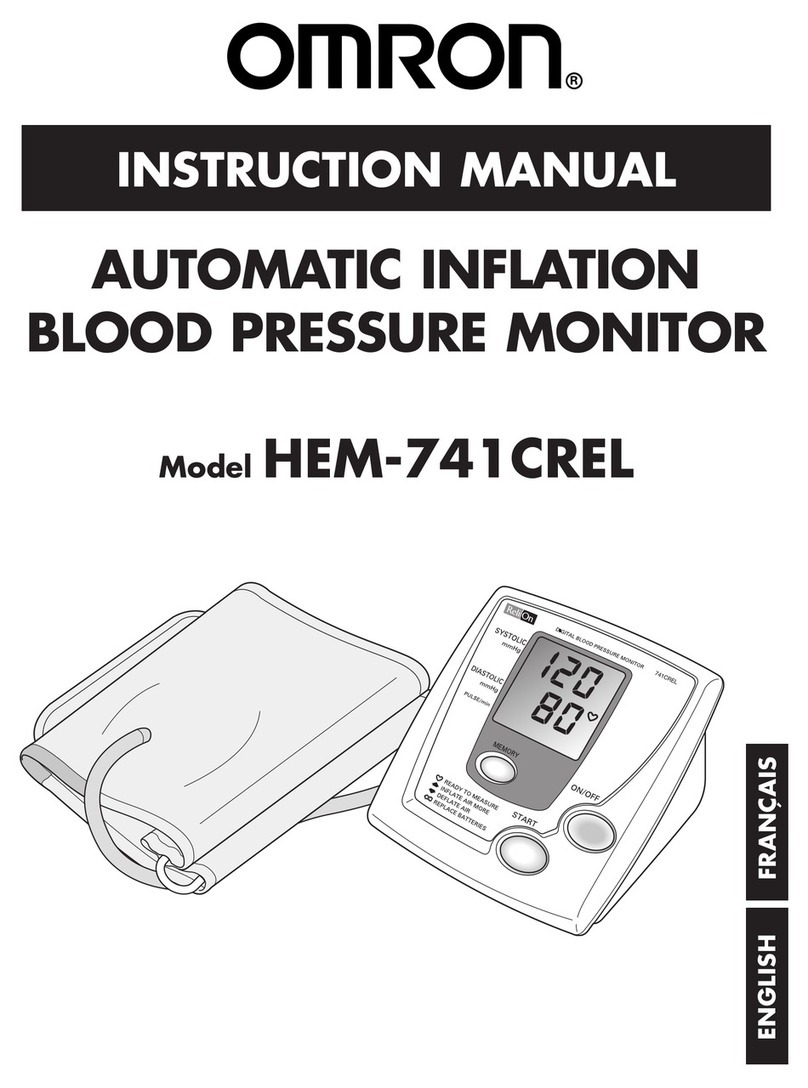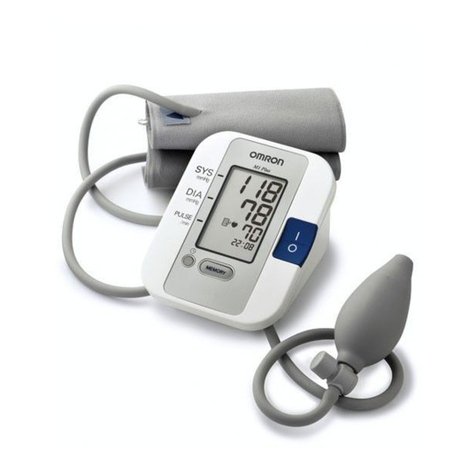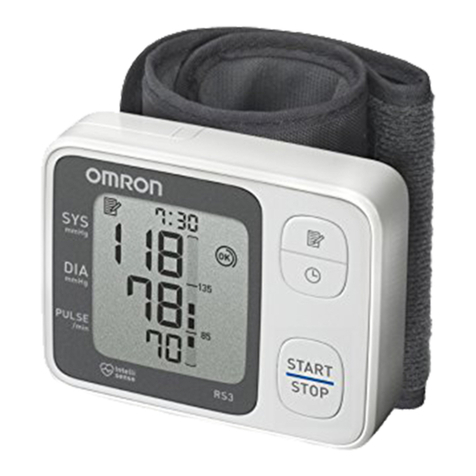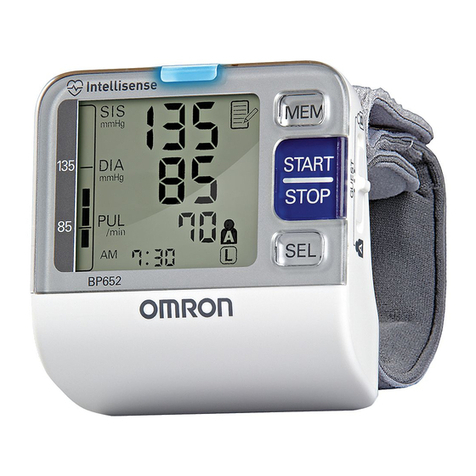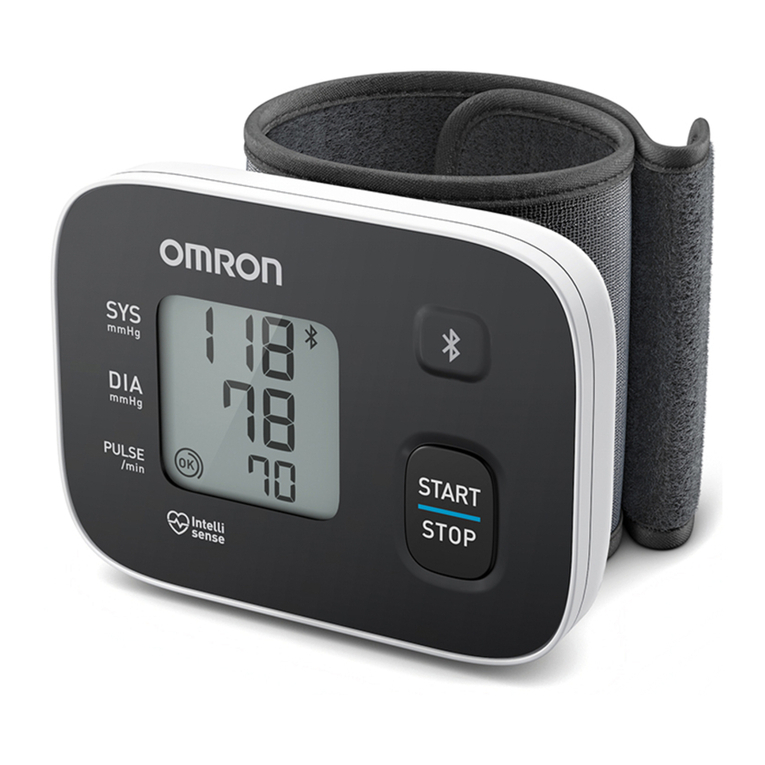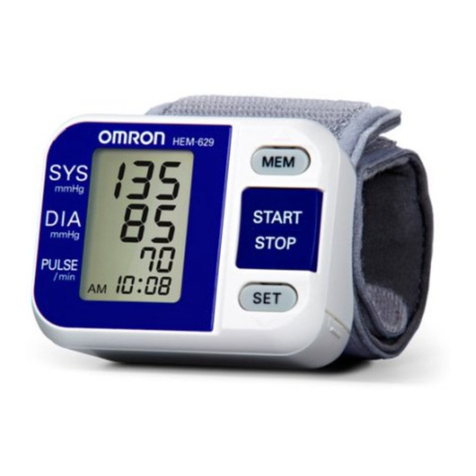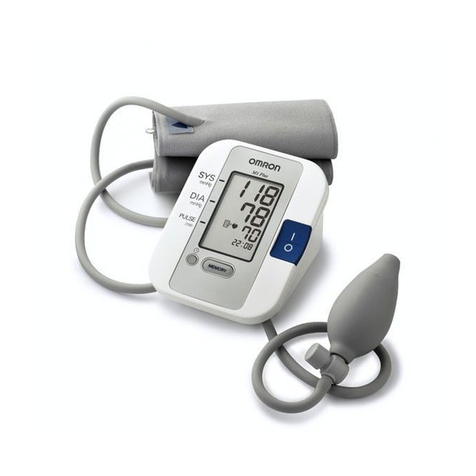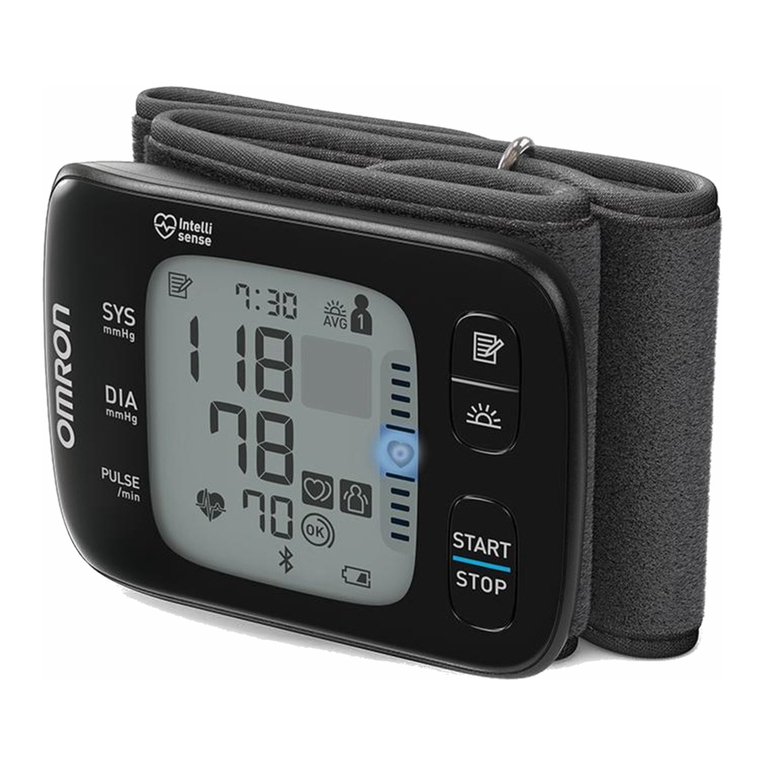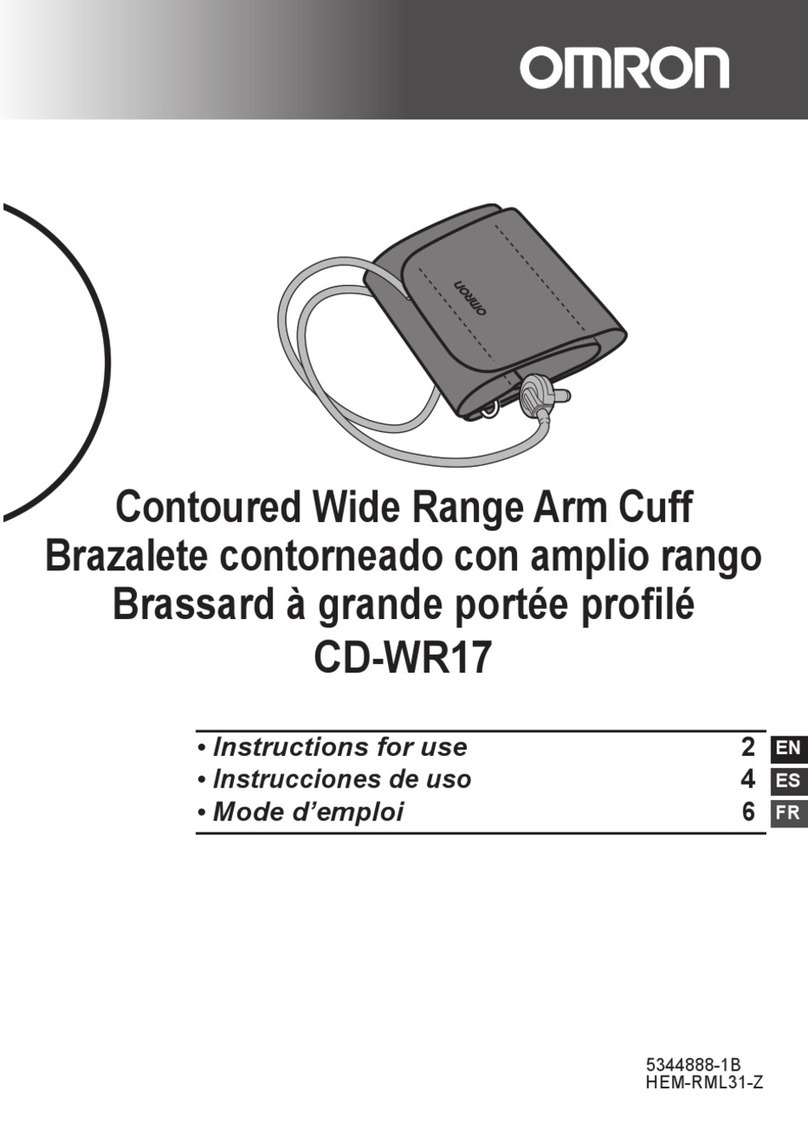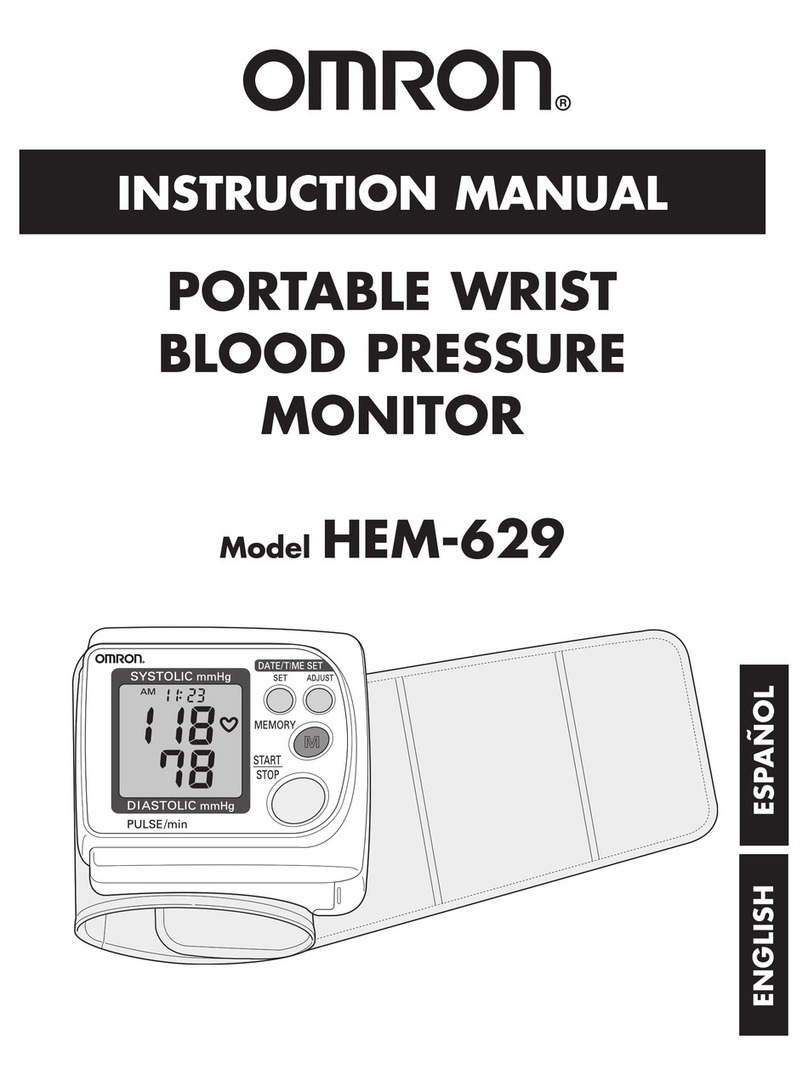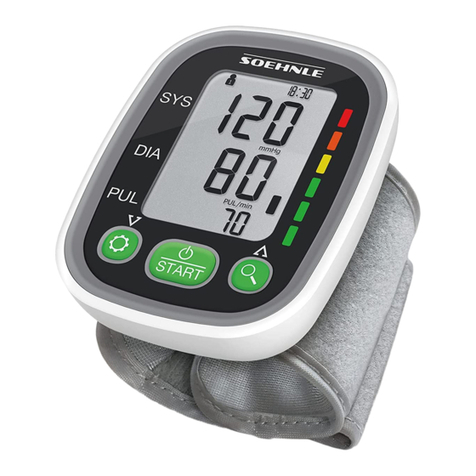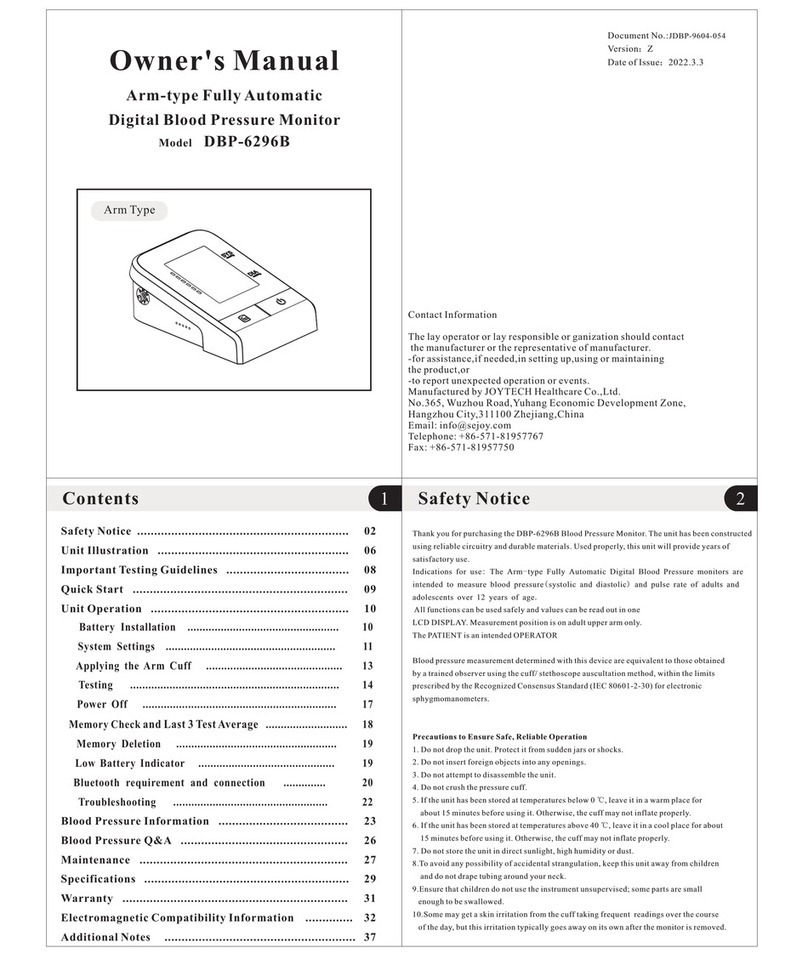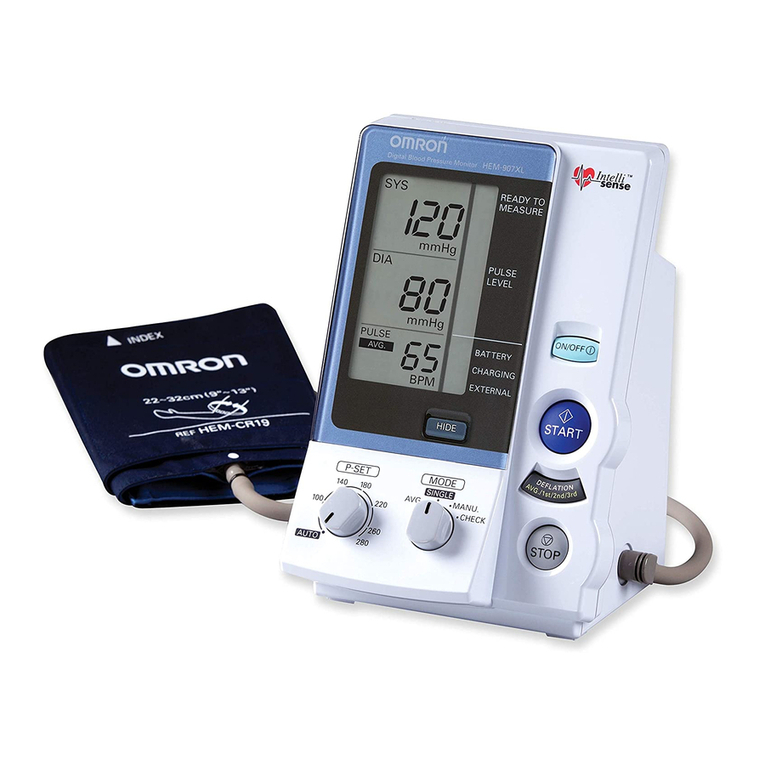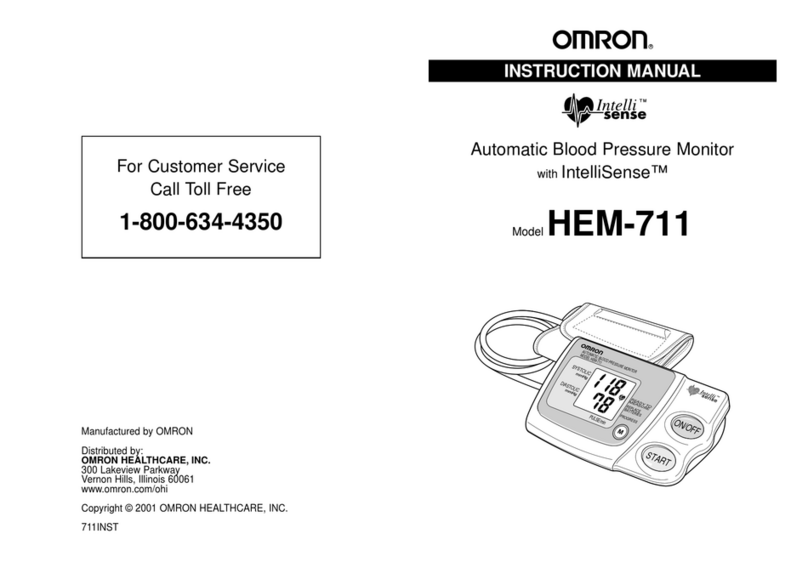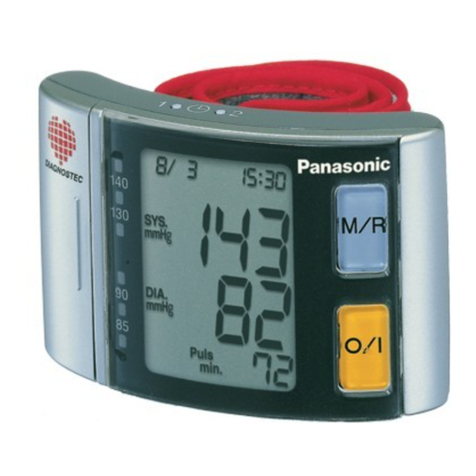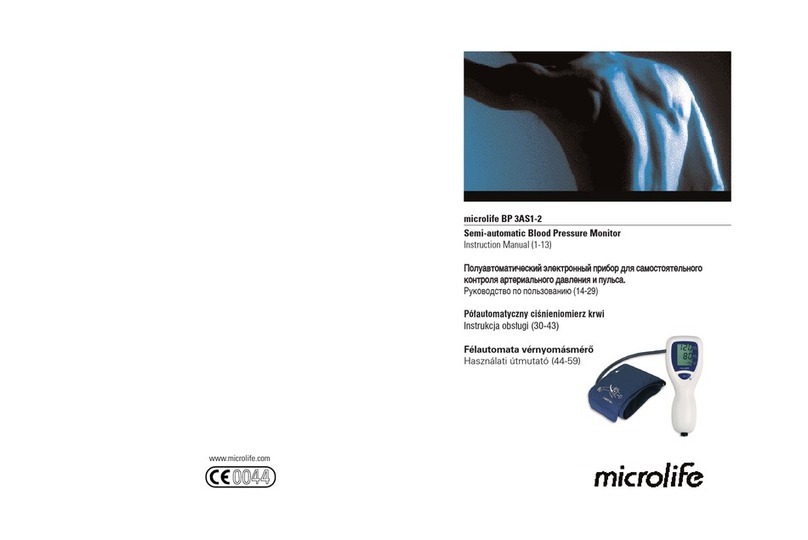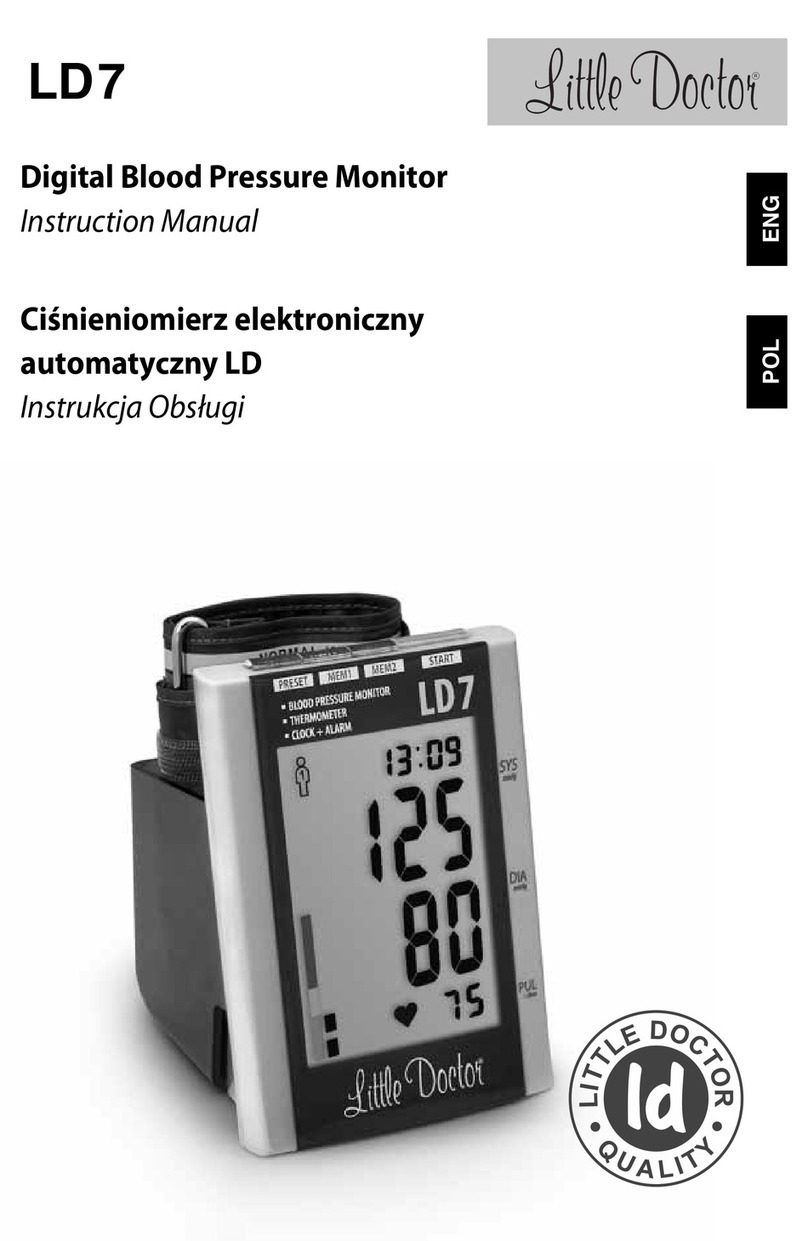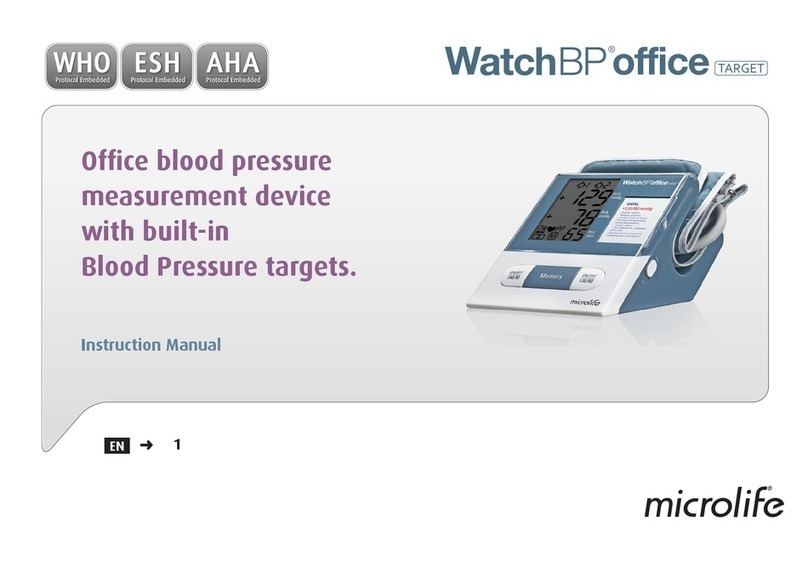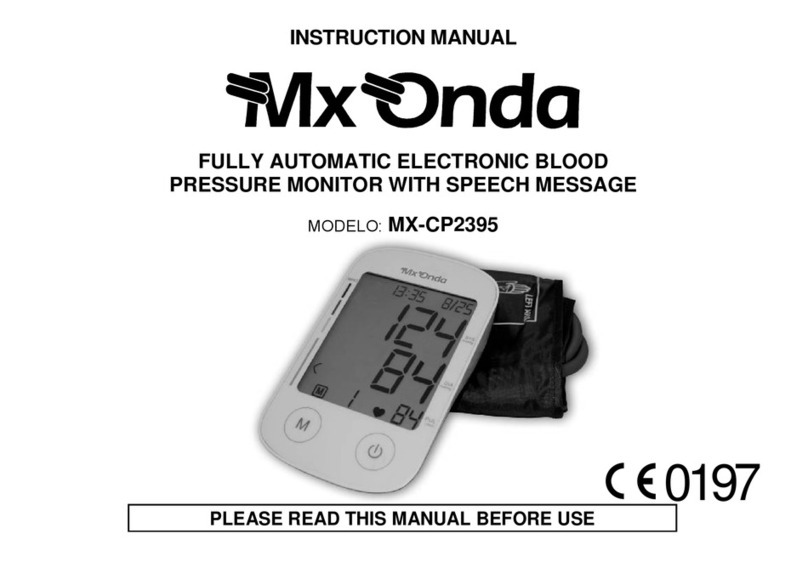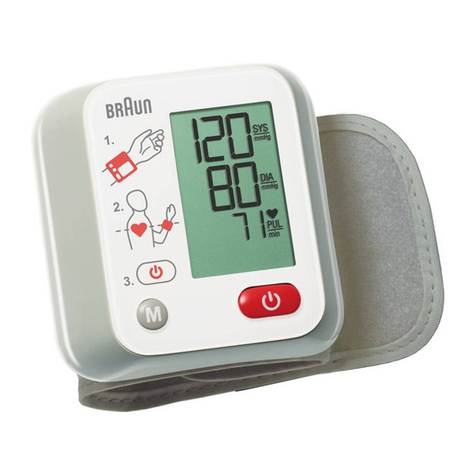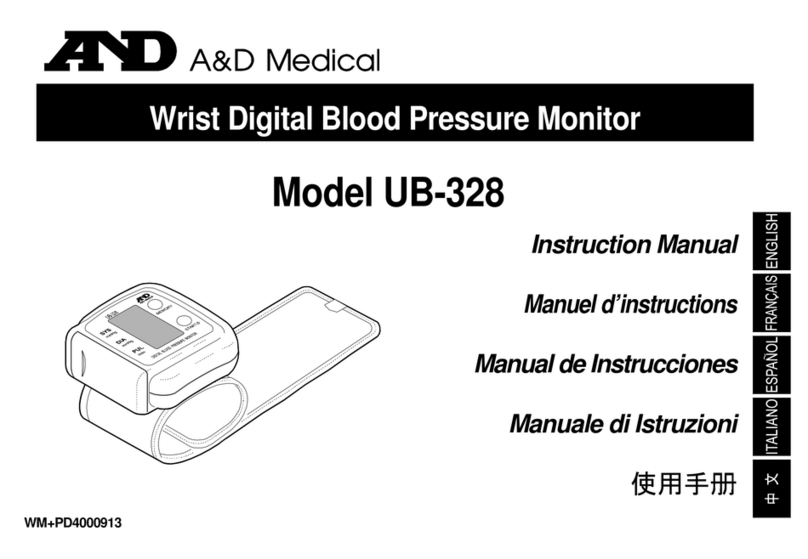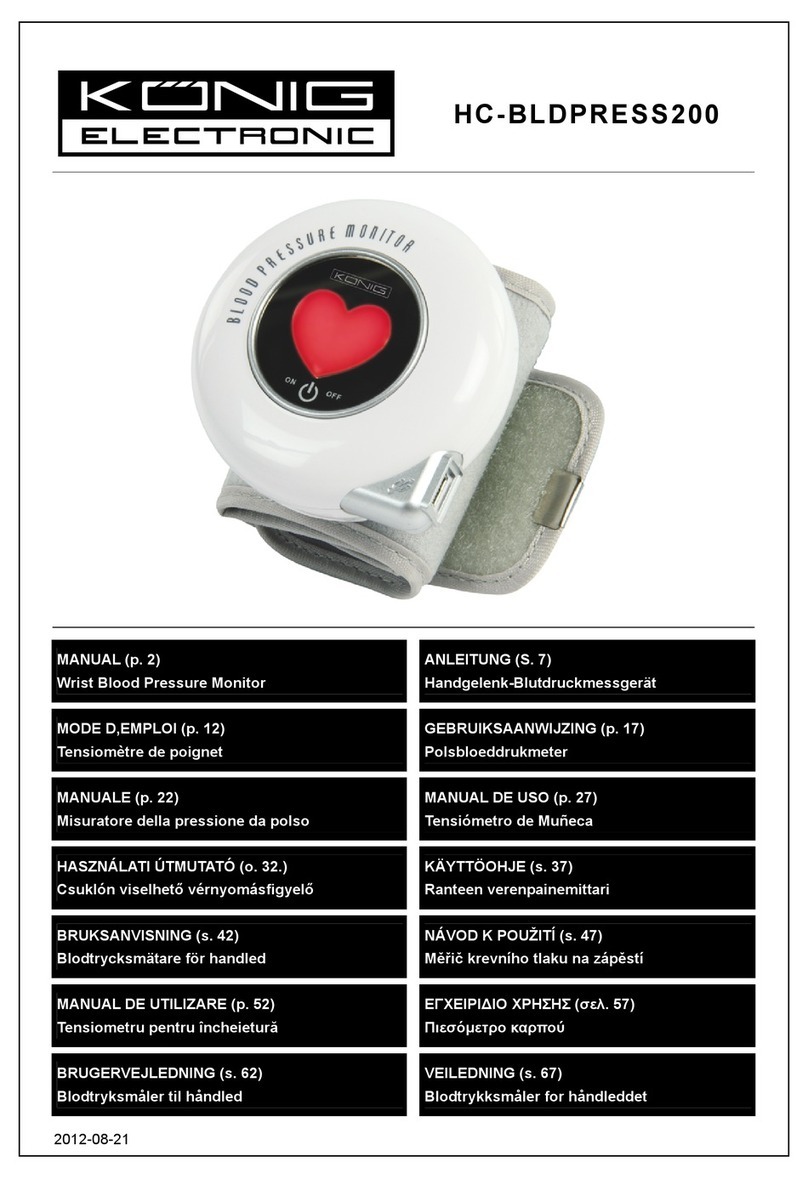
Introduction
Thank you for purchasing the OMRON Upper Arm Blood Pressure Monitor.
Your new upper arm blood pressure monitor uses the oscillometric method of
blood pressure measurement. This means the monitor detects your blood
movement through your brachial artery and converts the movements into a
digital reading. An oscillometric monitor does not need a stethoscope so the
monitor is simple to use.
Intended Use
This device is a digital monitor intended for use in measuring blood pressure and
pulse rate in adult patient population. The device detects the appearance of
irregular heartbeats during measurement and gives a warning signal with
readings. It is mainly designed for general household use.
Important Safety Information
Please read the Important Safety Information in this instruction manual
before using the unit.
Please follow this instruction manual thoroughly for your safety.
Please keep for future reference. For specific information about your own blood
pressure, CONSULT YOUR DOCTOR.
Warning Indicates a potentially hazardous situation which, if not
avoided, could result in death or serious injury.
• DO NOT adjust medication based on measurement results from this blood
pressure monitor. Take medication as prescribed by your doctor. Only a doctor
is qualified to diagnose and treat high blood pressure.
• DO NOT use this monitor on an injured arm or an arm under medical
treatment.
• DO NOT wear the arm cuff on your arm while on an intravenous drip or blood
transfusion.
• DO NOT apply or inflate the arm cuff around any body parts other than your
upper arm.
• DO NOT use this monitor in areas containing high frequency (HF) surgical
equipment, magnetic resonance imaging (MRI) equipment, computerized
tomography (CT) scanners or in oxygen rich environments.
• DO NOT use this monitor on infants, toddlers, children or persons who cannot
express themselves.
• Consult your doctor before using this monitor if you have common arrhythmias
such as atrial or ventricular premature beats or atrial fibrillation; arterial
sclerosis; poor perfusion; diabetes; pregnancy; pre-eclampsia; or renal
disease.
• Always consult your doctor. Self-diagnosis of measurement results and
self-treatment are dangerous.
• This product contains small parts that may cause a choking hazard if
swallowed by children, toddlers or infants.
• Keep the BATTERY out of the reach of children, toddlers and infants.
• This product emits radio frequencies (RF) in the 2.4 GHz band. DO NOT use
this product in locations where RF is restricted, such as on an aircraft or in
hospitals.
Caution Indicates a potentially hazardous situation which, if not
avoided, may result in minor or moderate injury to the
user or patient or damage to the equipment or other
property.
• Stop using this monitor and consult your doctor if you experience skin irritation
or discomfort.
• Consult your doctor before using this monitor on an arm with an arterio-venous
(A-V) shunt.
• Note that PATIENT motion, trembling, shivering may affect the measurement
reading.
• Consult your doctor before using this monitor if you have had a mastectomy.
• Consult your doctor before using the monitor if you have severe blood flow
problems or blood disorders as cuff inflation can cause bruising.
• Do not take measurements more often than necessary because bruising, due
to blood flow interference, may occur.
• Remove the arm cuff if it does not start deflating during the measurement.
• Do not use this monitor for any purpose other than measuring blood pressure.
• Do not use a mobile phone or other electrical devices that emit electromagnetic
fields near this monitor except when transferring your readings to your smart
device. This may result in incorrect operation of this monitor.
• Do not disassemble or attempt to repair the monitor or components. This may
cause an inaccurate reading.
• Do not use in a location where there is moisture or a risk of water splashing the
monitor. This may damage the monitor.
• Do not use this monitor in a moving vehicle such as in a car or on an aircraft.
Do not drop, or subject this monitor to strong shocks or vibrations.
• Do not use this monitor in places with high or low humidity or high or low
temperatures. See the “6. Specifications” section of the manual.
• Please check, by observation of the arm being used, that the monitor is not
causing any impairment of patient blood circulation.
• Do not use this monitor in high-use environments such as medical clinics or
doctor offices.
• Avoid bathing, drinking alcohol or caffeine, smoking, exercising and eating for
30 minutes before taking a measurement.
• Rest for at least 5 minutes before taking the measurement.
• Remove tight-fitting or thick clothing from your arm while taking a
measurement.
• Remain still and do not talk while taking a measurement.
• Read and follow the “Important information regarding Electro Magnetic
Compatibility (EMC)” in the EMC information provided with this device.
• Read and follow the “Correct Disposal of This Product” in “6. Specifications”
when disposing of the device and any used accessories or optional parts.
Data Transmission
• Do not replace the battery while your reading is being transferred to your smart
device. This may result in the incorrect operation of your monitor and failure to
transfer your blood pressure data.
• Do not place integrated circuit cards, magnets, metal objects, or other devices
that emit electromagnetic fields near this monitor while your reading is being
transferred to your smart device. This may result in the incorrect operation of
your monitor and failure to transfer your blood pressure data.
Battery Handling and Usage
• Do not insert the batteries with their polarities incorrectly aligned.
• Use only 4 “AAA” alkaline batteries with this monitor. Do not use other types of
batteries. Do not use new and used batteries together.
• Remove the batteries if the monitor will not be used for a long period of time.
• If battery fluid should get in your eyes, immediately rinse with plenty of clean
water. Consult a doctor immediately.
• If battery fluid should get on your skin, wash your skin immediately with plenty
of clean, lukewarm water. If irritation, injury or pain persists, consult a doctor.
• Do not use batteries after their expiration date.
• Periodically check your batteries to ensure they are in good working condition.
• Only use batteries specified for this monitor. Use of unsupported batteries may
damage and/or may be hazardous to the monitor.
1. Know Your Device
Contents:
Monitor, battery set, instruction manual, setup instructions
Monitor:
1.1 Display symbols
Irregular Heartbeat Symbol ( )
When the monitor detects an irregular rhythm
two or more times during the measurement, the
irregular heartbeat symbol will appear on the
display with the measurement values.
An irregular heartbeat rhythm is defined as a
rhythm that is 25% less or 25% more than the
average rhythm detected while the monitor is
measuring the systolic and diastolic blood
pressure.
If the irregular heartbeat symbol displays with your measurement results,
we recommend you consult your doctor. Follow the directions of your
doctor.
Movement Error Symbol ( )
The movement error symbol is displayed if you move your body during the
measurement. Please remove the arm cuff, and wait 2 - 3 minutes.
Take another measurement and remain still during measurement.
Cuff Wrap Guide Symbol ( / )
If the cuff was wrapped too loosely, it may cause unreliable results. If the
wrapping of cuff is too loose, the cuff wrap guide symbol “ ” appears.
Otherwise “ ” appears. This is the function which is used as an aid in
determining if the cuff is wrapped snugly enough.
SYNC Symbol ( )
• When the SYNC symbol appears on the display, make sure that your
monitor has been pairing with the smart device or transfer the data.
• When the SYNC symbol appears on the display, transfer the data before
the measurements are deleted. If the memory is full, the monitor will be
delete the oldest value. Maximum internal memory is for 100
measurements.
2013 ESH/ESC Guidelines for the management of arterial hypertension
Definitions of hypertension by office and home blood pressure levels
These are from statistical values for blood pressure.
1.2 Before Taking a Measurement
To help ensure an accurate reading, follow these directions:
1. Avoid bathing, drinking alcohol or caffeine, smoking, exercising and
eating for 30 minutes before taking a measurement.
2. Rest for at least 5 minutes before taking the measurement.
3. Stress raises blood pressure. Avoid taking measurements during
stressful times.
4. Measurements should be taken in a quiet place.
5. Remove tight-fitting clothing from your arm.
6. Keep a record of your blood pressure and pulse readings for your
doctor. A single measurement does not provide an accurate indication
of your true blood pressure. You need to take and record several
readings over a period of time. Try to measure your blood pressure at
the same time each day for consistency.
2. Preparation
2.1 Battery Installation
1. Remove the battery cover.
Gently slip into the gap of the
hook and pull downward.
2. Insert 4 “AAA” batteries as
indicated, into the battery
compartment.
3. Replace the battery cover.
When the batteries have been securely placed in this device, the message
and SYNC symbol below will appear on the screen:
Notes:
• When the depleted battery symbol “ ” appears on the display, turn the
monitor off and remove all the batteries. Replace with 4 new batteries at
the same time. Long life alkaline batteries are recommended.
• The measurement values continue to be stored in the memory even after
the batteries are replaced.
• The supplied batteries may have a shorter life than new batteries.
• Disposal of used batteries should be carried out in accordance with the
national/local regulations for the disposal of batteries.
2.2 Pairing Your Monitor with a Smart Device
The date and time on your monitor will automatically be set when you pair
it with your smart device.
To begin using the “OMRON connect” app for the first time, please visit
omronconnect.com/setup for the initial set-up instructions.
1. Turn on the Bluetooth feature of the smart device.
2. Download and install the free “OMRON connect” app on
your smart device.
* If you already have the “OMRON connect” app, go to:
Menu > Devices > Add Device
3. Open the app on your smart device and follow the set-up
and pairing instructions.
4. Confirm the monitor is connected successfully.
If the monitor is connected successfully to the smart device, “OK” will
appear on the display.
If “Err” appears, refer to “Connection failure. / Data is not being
transmitted.” in section 4.2 for more detail.
Notes:
• Pairing this monitor with the “OMRON connect” app on your smart device
will set the date and time on this monitor. Once you have paired with the
“OMRON connect” app, the date and time is now setup on this monitor,
all future measurements will include the date and time when you transfer.
If you do not pair this monitor to set the date and time, anyࠉ
measurements you take with this monitor will not include the date and
time.
• If you use an app other than the "OMRON connect" app, the date and
time may not be set automatically on your blood pressure monitor.
• Please be aware that OMRON will not be responsible for the loss of data
and/or information.
• If you use the monitor without pairing, refer to the “Using your Monitor
without Pairing” in the “3.3 Taking a Measurement”.
3. Using the Device
3.1 Applying the Arm Cuff
Remove tight-fitting clothing from your left upper arm.
Do not place the arm cuff over thick clothes.
1. Apply the arm cuff to your left upper
arm.
The bottom edge of the arm cuff should be 1
to 2 cm above the elbow. Positioning the
display in clear view of the user makes it
easier to read the results.
2. Securely close with the fabric
fastener.
Notes:
• The blood pressure can differ between
the right arm and the left arm, and the
measured blood pressure values can be
different. OMRON recommends to
always use the same arm for
measurement. If the values between both arms differ substantially, please
check with your doctor as to which arm to use for your measurements.
• Positioning the monitor with the [START/STOP] button towards the body
makes it easier to use the device.
3.2 How to Sit Correctly
To take a measurement, you need to be relaxed and
comfortably seated, at a comfortable room
temperature.
• Sit in a chair with your legs uncrossed and your feet flat on
the floor.
• Sit upright with your back straight.
• Sit with your back and arm being supported.
• The arm cuff should be placed on your arm at the same level as your heart.
3.3 Taking a Measurement
Notes:
• To stop the measurement, press the [START/STOP] button once to
deflate the arm cuff.
• Remain still and do not talk while taking a measurement.
• This device will store 100 measurements in the device. Stored
measurements cannot be viewed on the monitor's display. You will need
to use the “OMRON connect” app to view all measurements prior to the
most recent reading taken.
• Do not use the monitor with other electrical device simultaneously. This
may result in incorrect operation of the monitor.
1. Press the [START/STOP] button.
The arm cuff will start to inflate.
: The arm cuff was wrapped snugly enough.
: The arm cuff was loose or not wrapped correctly.
Note: The cuff wrap guide result appears on the display during the
measurement.
The following symbols indicate incorrect measurement
• If any of these symbols below are displayed, please take another
measurement.
2. Remove the arm cuff.
3. Transfer your readings.
Please make sure your monitor is within 5 m (16 ft.) of your smart device
and your “OMRON connect” app is active.
As soon as the measurement is complete, your reading will be
automatically transferred to the app.
Transferring your readings later
1. Open the app on your smart device and then follow the instructions.
2. Press connection button to transfer your readings.
• If your readings are successfully transferred to your smart device,
“OK” will flash on the display.
If “Err” appears, refer to “Connection failure. / Data is not being
transmitted.” in section 4.2 for more detail.
Notes:
• When the SYNC symbol “ ” appears on the display, transfer the data
immediately before the readings are deleted.
• When the Connection OFF symbol “ ” appears on the display, turn on
the Bluetooth feature of your monitor. (Refer to section 3.4)
• Once you send the your readings to the app, the data cannot be resent to
app or smart device.
4. After your readings have been transferred to the “OMRON
connect” app, press the [START/STOP] button to turn off.
Notes:
• The monitor will automatically turn off after 2 minutes.
• Wait 2-3 minutes before taking another measurement. Waiting between
measurements allows the arteries to return to their prior condition to
taking the measurement.
• If you use any other app instead of “OMRON connect”, the data may not
be displayed correctly after sending.
Data Transfer With Multiple Smart Devices
Once you transfer your data to a smart device, that data cannot be
transferred again to the same smart device, nor to another smart device.
About Multiple Users
This monitor is recommended for personal use.
When this monitor is used by more than one person, the measurement data
will be combined.
Using your Monitor without Pairing
You can use this blood pressure monitor without pairing to a smart device.
1. Apply the arm cuff. (Refer to section 3.1)
2. Press [START/STOP] button. (Refer to step 1 to 2 in section 3.3)
3.
Write down your SYS/DIA and Pulse readings, along with the date and time
of your measurement on a piece of paper to keep a record of your history.
Note: When using this blood pressure monitor without a smart device, you
will not be able to view your prior readings stored in the memory.
Upper Arm
Blood Pressure Monitor
Model HEM-7600T
Instruction Manual
Connection symbol Battery symbol (low)
Connection OFF symbol Battery symbol (depleted)
Connection ON symbol Deflation symbol
Movement error symbol Heartbeat symbol
(Flashes during measurement.)
SYNC symbol Cuff Wrap Guide Symbol
Irregular heartbeat symbol
Office Home
Systolic Blood Pressure ≥140 mmHg ≥135 mmHg
Diastolic Blood Pressure ≥90 mmHg ≥85 mmHg
A
BC
D
E
A. START/STOP button
B. Connection button
C. Display
D. Arm cuff
E. Battery compartment
F. Systolic blood pressure
G. Diastolic blood pressure
H. Pulse display
G
H
F
Irregular Heartbeat
Normal Heartbeat
Pulse
Blood pressure
Blood pressure
Short Long
Pulse
: Make sure to press the connection button to pair with the smart
device or transfer the data before taking a measurement when
the SYNC symbol “”appears.
Review the list of compatible smart devices at:
omronconnect.com/devices
For details, visit: omronconnect.com
START INFLATING DEFLATING
COMPLETED
DO NOT adjust medication based on measurement results from this blood
pressure monitor. Take medication as prescribed by your doctor. Only a
doctor is qualified to diagnose and treat high blood pressure.
Always consult your doctor. Self-diagnosis of measurement results and
self-treatment are dangerous.
3125186-3A
HEM-7600T-AP3_A_M03_170119.fm 1
